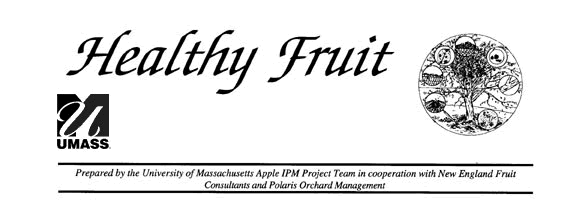
|
|
|---|
On the apple maggot front, there have been no real surprises thus far in monitored orchards. Accumulation of AMF on unbaited spheres is progressing fairly slowly; statewide, traps are averaging roughly 1 AMF capture per trap. On early varieties in a few orchards, AMF have begun to build to more substantial numbers—captures up to 4 AMF per trap (exceeding the recommended treatment threshold), with no damage detected thus far. In all monitored orchards, AMF captures on mid- to late-ripening cultivars are consistently low, with few orchards harboring enough AMF to warrant full-scale treatment.
This year's observations, coupled with the general lack of fruit on unmanaged trees last season, indicate that AMF will likely pose less of a threat than in recent years. However, we do expect that the risk of AMF injury will build relatively early in the season, and early-ripening cultivars such as Jersey Mac, Vista Bella, and Paula Red may benefit from a treatment with Imidan or Guthion made in the next week. As mentioned in previous issues of Healthy Fruit, a reduced rate of either material is generally sufficient for control of moderate populations of AMF on early cultivars.
Despite ideal weather for accumulation of European red mites and two-spotted mites during late June, very few orchards have experienced significant stress associated with mite feeding. Only spotty areas with mite problems have been observed, and most orchards receiving a full oil program or an early-season acaricide application remain clean to date. TSM, which are known to generate a threat much more rapidly than ERM, did warrant treatment in one block, and a handful of orchards have used a summer treatment against ERM.
For the latter half of July, we recommend that treatment be considered if more than 80% of middle-aged leaves (sampled throughout the canopy) are found to be infested with 1 or more motile mites. If summer treatment is necessary, Pyramite and Apollo remain as the recommended materials, though Apollo requires a 45-day preharvest interval, which may have passed for use on some cultivars. Regardless of the material used for summer mite control, management of resistance development should always be a consideration, as mites are notorious for their ability to build up resistance to materials used consistently over the course of only a few years.
Evidence of woolly apple aphid presence has been observed in low levels in most orchards across the state, generally seen as white, fluffy protrusions from watersprouts and pruning cuts. Unfortunately, there is some question as to accuracy of using foliar presence of WAA as an indicator of a damaging population, as there is no direct correlation between the visible population and the level of subsurface (damaging) infestation. However, the above-ground population can indirectly impact the fruit quality, as the sugary drizzle from infested cuts offers an ideal site for development of sooty mold. That said, we recommend a tentative treatment threshold of 50% infestation of pruning cuts; if treatment against WAA is necessary, a half-rate of Thiodan should clear up the risk of further damage.
In the next month or so, it is likely that the manufacturers of methyl parathion (in conjunction with the EPA) will withdraw this material for use on fruit crops. This will have little impact on this region's apple production, as few growers depend on this material in any substantial role. However, some growers in the region rely on use of methyl parathion as a trunk and scaffold spray for use against borers on peaches, which will not likely be permitted in the near future. For growers who regularly use methyl parathion against borers on peach trees, we recommend use of Lorsban as an effective alternative.
Healthy Fruit is written by Dan Cooley, Ron Prokopy, Starker Wright, Wes Autio, and Duane Greene except where other contributors are noted. Edited by Dan Cooley. Publication is funded in part by the UMass Extension Agroecology Program, grower subscriptions, and the University of Massachusetts IPM Program. A text version can be e-mailed to you if you contact Doreen York. Please cite this source if reprinting information.